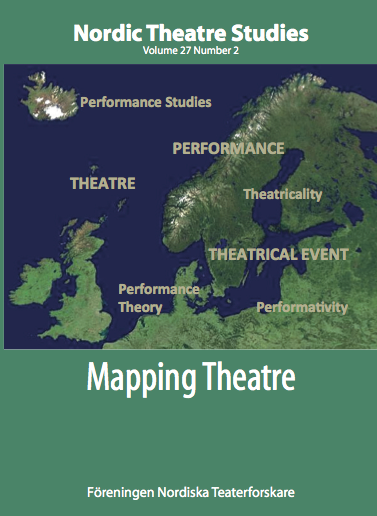Stage Design at the Crossroads of Different Operational Cultures. Mapping the History of Scenography Education in Finland
DOI:
https://doi.org/10.7146/nts.v27i2.24253Keywords:
scenography, stage design, University of Industrial Arts, Helsinki, theatre education, theatre professionsAbstract
The article maps the development of scenography education in Finland from the early 1970s to the 2000s. Unlike all other disciplines of theatre making, the study program has been located at the University of Industrial Arts, which highlights the double character of scenography as both a visual and a performative art. The hegemonic comprehension of the subject has oscillated between independent design and participation in a collective process. The key question that penetrates the curriculum throughout the decades is how to successfully construct a solid, material space for a temporary, more or less unpredictable theatrical event. The scenographic methods that have been taught vary from the disciplined rational pre-planning and conceptual analysis of the 1970s, to the subjective individualism at the turn of the 1980s and 1990s, and finally to the interactive, self-regulating processes in the 2000s. The different approaches are largely connected to individual teachers, but they can be further contextualized by looking at the more general cultural tendencies in art, theatre and society; as well as to the material conditions, changing university policies and respective organizational reformations.References
Claire Bishop, Installation Art. A Critical History, Tate Publishing, London 2005.
Erika Fischer-Lichte, The Transformative Power of Performance, Routledge, London and New York, 2008.
Kaj Franck, Muotoilijan tunnustuksia,Valtion painatuskeskus, Helsinki, 1989.
Reija Hirvikoski, “Vastatuulessa venekin kulkee kovempaa” in Måns Hedström. Teatterin visuaalinen suunnittelija, Anneli Ollikainen, ed., Theatre Museum, Helsinki 2007.
Ilkka Huovio, Invitation from Future. Treatise on the Roots of the School of Arts and Crafts and its Development into a University Level School, Tampere University, Tampere 1998.
Ilkka Huovio, “Veistokoulusta korkeakouluksi” in Ateneum Maskerad, Taideteollisuuden muotoja murroksia, Yrjö Sotamaa & al., eds., UIAH, Helsinki 1999.
Liisa Ikonen, Dialogista skenografiaa. Vaihtoehtoisen työprosessin fenomenologista tulkintaa, UIAH, Helsinki, 2006.
Liisa Ikonen, Mistä kuvat tulevat? Licentiate Thesis, UIAH, Helsinki 1998.
Laura Jäntti, “Haastaja ja kannustaja” in Måns Hedström. Teatterin visuaalinen suunnittelija, Anneli Ollikainen, ed., Theatre Museum, Helsinki 2007.
Harri Kalha, Ralf Forström Scenografi 1963-1998, Otava, Helsinki 1999.
Harri Kalha, “Sankarien sukupolvi” in Ateneum Maskerad Taideteollisuuden muotoja murroksia, Yrjö Sotamaa & al., eds., UIAH, Helsinki 1999.
Timo Kallinen, Teatterikorkeakoulun synty. Ammattikoulusta akatemiaksi 1971-1991, Like, Helsinki 2004.
Pekka Korvenmaa, “Tietoisuuden tasot” in Ateneum Maskerad, Taideteollisuuden muotoja murroksia, Yrjö Sotamaa & al., eds., UIAH, Helsinki 1999.
Seppo Kumpulainen, Hikeä ja harmoniaa. Liikunnan ja fyysisen ilmaisun opetus Suomen Teatterikoulun ja Teatterikorkeakoulun näyttelijänkoulutuksessa vuosina 1943-2005, Theatre Academy, Helsinki 2011.
Outi Lahtinen, “Koulutusta teatteriammatteihin” in Suomen teatteri ja draama, Mikko-Olavi Seppälä, Katri Tanskanen, eds., Like, Helsinki 2010.
Pekka Milonoff, “Älkää unohtako leikkiä” in Måns Hedström. Teatterin visuaalinen suunnittelija, Anneli Ollikainen, ed., Theatre Museum, Helsinki 2007.
Heta Reitala, Harha on totta. Näkökulmia suomalaiseen lavastukseen ja pukusuunnitteluun 1900-luvun alusta nykypäivään, Atena, Helsinki 2005.
Liisa Räsänen, “Taiteellinen johtaja Kaj Franck” in Ateneum Maskerad, Taideteollisuuden muotoja murroksia, Yrjö Sotamaa & al., eds., UIAH, Helsinki 1999.
Oskar Schlemmer, “Man and Art Figure” in The Theater of the Bauhaus, Walter Gropius, A. S. Wensinger, eds., Wesleyan University Press, Middletown, Connecticut 1961.
Richard Sennett, The Culture of the New Capitalism, Yale University Press, New Haven and London 2006.
Auli Suortti-Vuorio, “Atskilaiset, taikkilaiset,...keitä?” in Ateneum Maskerad, Taide- teollisuuden muotoja murroksia, Yrjö Sotamaa & al., eds., UIAH, Helsinki 1999.
Janne Tapper, “Jon MacKenzien nykyesityksen teorian tulkinnasta: käsitteet pölytys, immanenssi ja hyve” in Esitystutkimus, Annette Arlander & al., eds., Partuuna, Helsinki 2015.
Janne Tapper, Jouko Turkan Teatterikorkeakoulun kauden yhteiskunnallinen kontekstuaalisuus vuosina 1982-1985, Helsinki University, Helsinki, 2012.
Janne Tapper, “Työ, työntekijyys ja yhteiskunta Jouko Turkan teatterikoulutuksessa” in Nykynäyttelijän taide. Horjutuksia ja siirtymiä, Marja Silde, ed., TeaK, Maa- henki, Helsinki 2011.
Susan Vihma, “Peruskurssi” in Ateneum Maskerad. Taide- teollisuuden muotoja murroksia, Yrjö Sotamaa & al., eds., UIAH, Helsinki 1999.
Downloads
Published
How to Cite
Issue
Section
License
The copyright belongs to the authors and Nordic Theatre Studies. Users can use, reuse and build upon the material published in the journal but only for non-commercial purposes. Users are allowed to link to the files, download the files, distribute the files on a local network (preferably by links), upload the files to local repositories if their institutions require them to do so, but not republish the files without proper agreements with the journal and the author.

